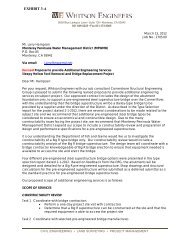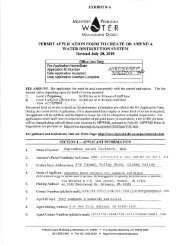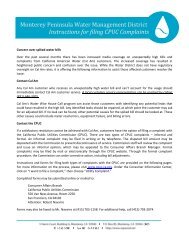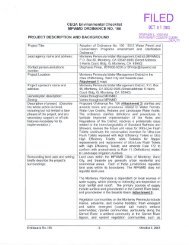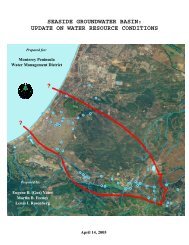FINAL REPORT Evaluation of Seawater Desalination Projects ...
FINAL REPORT Evaluation of Seawater Desalination Projects ...
FINAL REPORT Evaluation of Seawater Desalination Projects ...
Create successful ePaper yourself
Turn your PDF publications into a flip-book with our unique Google optimized e-Paper software.
EVALUATION OF SEAWATER DESALINATION PROJECTS<br />
PROPOSED FOR THE MONTEREY PENINSULA<br />
MLPP Units 6 & 7 intake with the proposed amount <strong>of</strong> free chlorine and a combined 21<br />
minutes <strong>of</strong> contact time in the coagulation and flocculation processes.<br />
Other concerns <strong>of</strong> the B-E evaluation team regarding the CWP are the allocation <strong>of</strong> the<br />
physical pathogen removal credits, identification <strong>of</strong> a target for total dissolved solids (TDS),<br />
and the possible presence <strong>of</strong> synthetic organic chemicals (SOCs) in Moss Landing Harbor.<br />
The CWP CDR does not specify how the physical pathogen removal credits for Giardia,<br />
Cryptosporidium, and viruses will be allocated throughout the treatment process by the State<br />
<strong>of</strong> California Department <strong>of</strong> Health Services (CDHS) nor does it identify a target for TDS.<br />
All <strong>of</strong> these issues warrant more detailed planning as the CWP enters the pilot stage.<br />
Areas <strong>of</strong> concern to the B-E evaluators for the MBRSDP are the information gaps provided<br />
by the MBRSDP CDR 2 regarding the allocation <strong>of</strong> physical pathogen removal credits,<br />
pesticides and agricultural run<strong>of</strong>f, and the use <strong>of</strong> chloramines to comply with CDHS<br />
disinfection requirements. However, the CDR does note that formation <strong>of</strong> DBPs would not<br />
be a concern due to the low TOC levels compared with CWP TOC levels.<br />
In addition to the information gaps, the most significant water quality concerns identified by<br />
the B-E evaluators associated with the MBRSDP involve the diverse systems owned by the<br />
Pajaro/Sunny Mesa Community Services District (P/SMCSD). The MBRSDP CDR<br />
indicates that the water produced by the plant is compatible with the water in the P/SMCSD’s<br />
distribution system. With customers not yet identified and a variety <strong>of</strong> disparate water<br />
qualities among the systems owned by the P/SMCSD, however, this claim cannot be<br />
substantiated. If the water quality is moderately different, it may be infeasible to treat the<br />
desalinated water to match that <strong>of</strong> the receiving water <strong>of</strong> each system. Moreover, additional<br />
pipe loop and/or coupon testing 3 may need to be conducted for the piping in each receiving<br />
system.<br />
A major area <strong>of</strong> concern to the B-E evaluators for the SCDP is the occasional non-point<br />
source pollution, which could potentially cause the beach wells to become infiltrated with<br />
enteric viruses, SOCs, pharmaceutical residuals, and/or endocrine disruptors. Because there<br />
are no test wells constructed at this stage <strong>of</strong> project development, the potential for such<br />
contamination cannot be accurately assessed. However, the acknowledgement and<br />
awareness <strong>of</strong> this possible contamination is important at this early stage <strong>of</strong> project<br />
development.<br />
2 P/SMCSD in cooperation with Poseidon Resources Corporation, April 2006.<br />
3 Pipe loop and coupon testing are used to determine the corrosion potential <strong>of</strong> the material by exposing a<br />
sample <strong>of</strong> the pipe or pipe material to the water. Highly purified water can be very corrosive to some pipe<br />
materials.<br />
Monterey Peninsula Water Management District<br />
ES-5




